There is just no easy way to explain an Internet Identity Workshop. It is an unconference, which is important, but that’s not really sufficient to explain it. It attracts a group of people who care deeply about Internet identity technology, its design and adoption, and its social, political, and economic impact. Many of them are people who have debated, supported, and known each other for a long time, so there is a sense of camaraderie. But it’s definitely not a closed group. It’s outrageously open and inclusive of newbies. Some of the most important decisions and leaps of progress in Internet identity systems have happened at IIW, or as a result of relationships established there. In addition to all of that, there is the untalent show, which is unfortunately self explanatory.
The great usefulness and significance of IIW is hard to explain. You just need to go to the next one.
On the opening day of this IIW I gave an overview presentation of the Open Source Identity System (OSIS) working group of the Identity Commons. After that there was a “speed geeking” event in which fellow Bandit Andy Hodgkinson showed the Higgins Native Identity Agent — an open source application that is roughly functionally equivalent to Microsoft’s Cardspace. Andy is the primary author of the code and finally got a chance to escape from his office for a while and show it off in person.
On Tuesday the OSIS group held a long working session in which we brought together many projects to collaboratively test a set of capabilities and scenarios. By all accounts it was a resounding success. Code from many projects worked together in multiple combinations and end-to-end scenarios. We had far more projects involved than I expected, we checked numerous scenarios, and many bugs and inconsistencies were identified — some fixed on the spot.
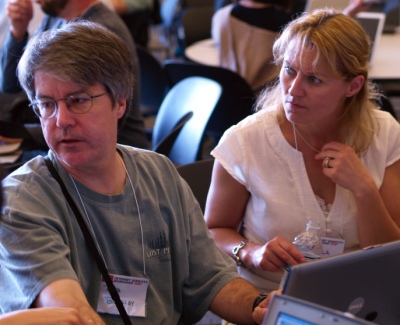 Bob Blakley moderated the session and managed to get everyone moving productively even though things didn’t start off quite as planned. The wireless network had become rather unstable. Most developers had difficulty getting an address via DHCP, and even when they did, the routing configuration was off and we could not connect to external servers. At one point Pamela Dingle became a human DHCP server and manually assigned IP addresses to each participant with correct routing information.
Bob Blakley moderated the session and managed to get everyone moving productively even though things didn’t start off quite as planned. The wireless network had become rather unstable. Most developers had difficulty getting an address via DHCP, and even when they did, the routing configuration was off and we could not connect to external servers. At one point Pamela Dingle became a human DHCP server and manually assigned IP addresses to each participant with correct routing information.
The fun was watching the different participants work through the process. Here are some photos of Andy Hodgkinson, Chuck Mortimore, Tony Nadalin, Ian Brown, and Kim Cameron as they collaborated on information card selector implementations:


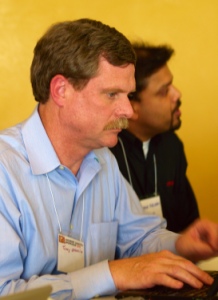
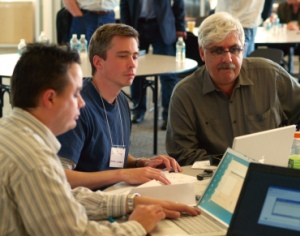
There was a team from Oracle that was attempting to get their relying party code to work with the various Identity Provider and Identity Agent projects. Things didn’t work at first, but … the expressions on their faces say it all.

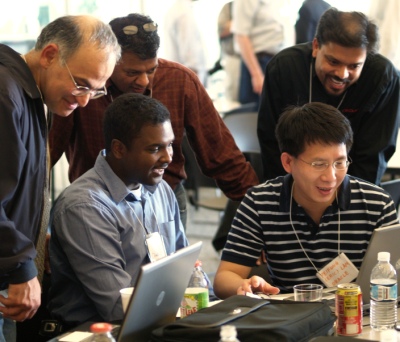
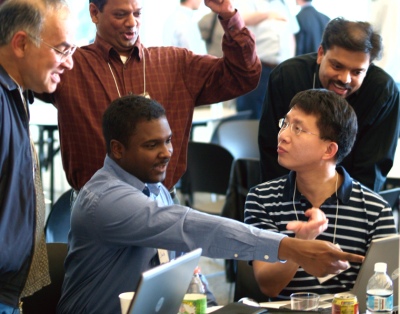
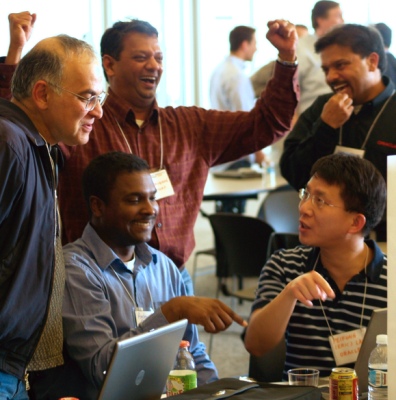
Then the Oracle team asked me to take their photo with Kim. Now that’s a friendly interoperability event.
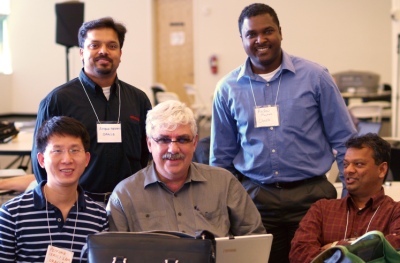 The OSIS session at IIW was intended to be an informal interaction that would help projects prepare for the more formal, and more visible, Catalyst Interop Event. Not only did it succeed in that goal, but I think most participants accelerated their understanding, improved their code, and raised their expectations for what we can show at Catalyst.
The OSIS session at IIW was intended to be an informal interaction that would help projects prepare for the more formal, and more visible, Catalyst Interop Event. Not only did it succeed in that goal, but I think most participants accelerated their understanding, improved their code, and raised their expectations for what we can show at Catalyst.
Of course there was much more done at IIW than this OSIS working group session. Phil Windley blogged a series of daily overviews.
There were a number of significant trends that seemed to me to take root at this IIW. Clearly there was a stronger interest in political and legal issues surrounding Internet identity systems. I think this is because the implementations and deployments are happening, and as people actually use this stuff they encounter subtle changes in their thinking. We start to actually think in more social terms in our internet use. It is fairly easy to recognize that there must be numerous points of contact between the identity systems and the legal system. I am sure there will be much more emphasis and discussion on these issues in the future. I know my own thoughts in these areas are still fermenting.
 Another trend of this IIW was the increased emphasis on marketing. One session resulted in a new Identity Marketing working group of the Identity Commons.
Another trend of this IIW was the increased emphasis on marketing. One session resulted in a new Identity Marketing working group of the Identity Commons.
The Bandit team was fortunate to be right in sync with this trend. We managed to get our Novell marketing representative (and Bandit-at-heart) Carolyn Ford to attend. Carolyn managed to soak up a huge amount of information and IIW culture in a short time.
After IIW I attended a meeting of the ITU-T Focus Group on Identity Management that took advantage of the IIW attendance to co-locate its meeting to Mountain View. While the meeting was vastly different than IIW and hosted by a vastly different organizational culture, it confirmed that the same issues around identity systems for networked devices are coming up in many areas.
 The trip to the conference was an adventure in itself. It started with ticket confusion and delays for international bag check-in, then long security lines out into the airport parking lot, running to another terminal with shorter lines, sprinting down the concourse only to be told that the paperwork had already been done and I could not board (even though the plane was right there and the door was not shut when I arrived). Sigh. Missed flight. Reschedule. Another missed flight in Atlanta due to lack of an available (airplane) parking place. Reroute through Paris. I’d never been to Paris before. Now I can say that I’ve run through a very nice airport in Paris. About 24 hours after I left home, I got to Munich.
The trip to the conference was an adventure in itself. It started with ticket confusion and delays for international bag check-in, then long security lines out into the airport parking lot, running to another terminal with shorter lines, sprinting down the concourse only to be told that the paperwork had already been done and I could not board (even though the plane was right there and the door was not shut when I arrived). Sigh. Missed flight. Reschedule. Another missed flight in Atlanta due to lack of an available (airplane) parking place. Reroute through Paris. I’d never been to Paris before. Now I can say that I’ve run through a very nice airport in Paris. About 24 hours after I left home, I got to Munich.




 All very good reasons, but the reason I was particularly interested in attending DEC was a chance to help with an identity system used at the conference and get almost-real-world deployment experience for Bandit and Higgins components. The conference identity system in question involved information cards, embarassing photographs, and a large poultry impersonator. After all, it was in Las Vegas.
All very good reasons, but the reason I was particularly interested in attending DEC was a chance to help with an identity system used at the conference and get almost-real-world deployment experience for Bandit and Higgins components. The conference identity system in question involved information cards, embarassing photographs, and a large poultry impersonator. After all, it was in Las Vegas.